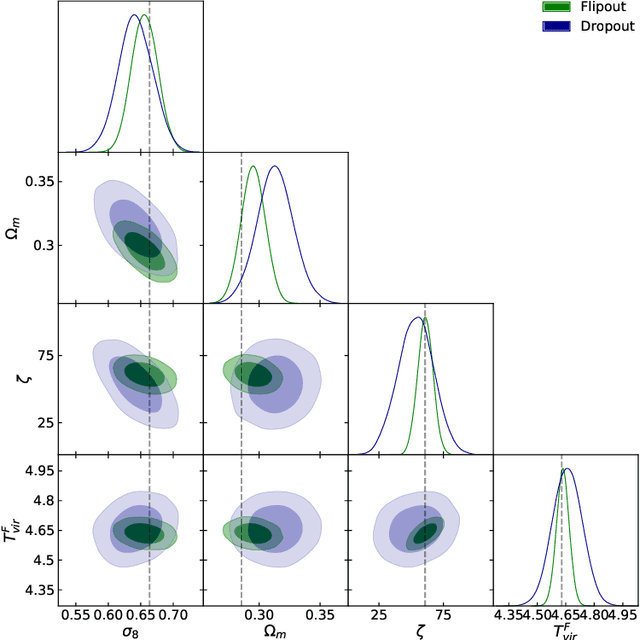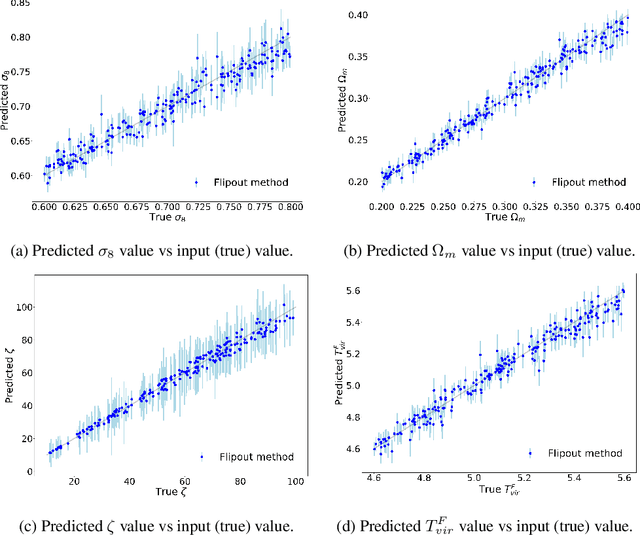Héctor J. Hortúa
Bayesian Inference of Primordial Magnetic Field Parameters from CMB with Spherical Graph Neural Networks
Oct 23, 2025Abstract:Deep learning has emerged as a transformative methodology in modern cosmology, providing powerful tools to extract meaningful physical information from complex astronomical datasets. This paper implements a novel Bayesian graph deep learning framework for estimating key cosmological parameters in a primordial magnetic field (PMF) cosmology directly from simulated Cosmic Microwave Background (CMB) maps. Our methodology utilizes DeepSphere, a spherical convolutional neural network architecture specifically designed to respect the spherical geometry of CMB data through HEALPix pixelization. To advance beyond deterministic point estimates and enable robust uncertainty quantification, we integrate Bayesian Neural Networks (BNNs) into the framework, capturing aleatoric and epistemic uncertainties that reflect the model confidence in its predictions. The proposed approach demonstrates exceptional performance, achieving $R^{2}$ scores exceeding 0.89 for the magnetic parameter estimation. We further obtain well-calibrated uncertainty estimates through post-hoc training techniques including Variance Scaling and GPNormal. This integrated DeepSphere-BNNs framework not only delivers accurate parameter estimation from CMB maps with PMF contributions but also provides reliable uncertainty quantification, providing the necessary tools for robust cosmological inference in the era of precision cosmology.
Forecasting VIX using Bayesian Deep Learning
Jan 30, 2024Abstract:Recently, deep learning techniques are gradually replacing traditional statistical and machine learning models as the first choice for price forecasting tasks. In this paper, we leverage probabilistic deep learning for inferring the volatility index VIX. We employ the probabilistic counterpart of WaveNet, Temporal Convolutional Network (TCN), and Transformers. We show that TCN outperforms all models with an RMSE around 0.189. In addition, it has been well known that modern neural networks provide inaccurate uncertainty estimates. For solving this problem, we use the standard deviation scaling to calibrate the networks. Furthermore, we found out that MNF with Gaussian prior outperforms Reparameterization Trick and Flipout models in terms of precision and uncertainty predictions. Finally, we claim that MNF with Cauchy and LogUniform prior distributions yield well calibrated TCN and WaveNet networks being the former that best infer the VIX values.
Constraining cosmological parameters from N-body simulations with Variational Bayesian Neural Networks
Jan 09, 2023



Abstract:Methods based on Deep Learning have recently been applied on astrophysical parameter recovery thanks to their ability to capture information from complex data. One of these methods is the approximate Bayesian Neural Networks (BNNs) which have demonstrated to yield consistent posterior distribution into the parameter space, helpful for uncertainty quantification. However, as any modern neural networks, they tend to produce overly confident uncertainty estimates and can introduce bias when BNNs are applied to data. In this work, we implement multiplicative normalizing flows (MNFs), a family of approximate posteriors for the parameters of BNNs with the purpose of enhancing the flexibility of the variational posterior distribution, to extract $\Omega_m$, $h$, and $\sigma_8$ from the QUIJOTE simulations. We have compared this method with respect to the standard BNNs, and the flipout estimator. We found that MNFs combined with BNNs outperform the other models obtaining predictive performance with almost one order of magnitude larger that standard BNNs, $\sigma_8$ extracted with high accuracy ($r^2=0.99$), and precise uncertainty estimates. The latter implies that MNFs provide more realistic predictive distribution closer to the true posterior mitigating the bias introduced by the variational approximation and allowing to work with well-calibrated networks.
Constraining the Reionization History using Bayesian Normalizing Flows
May 14, 2020



Abstract:The next generation 21 cm surveys open a new window onto the early stages of cosmic structure formation and provide new insights about the Epoch of Reionization (EoR). However, the non-Gaussian nature of the 21 cm signal along with the huge amount of data generated from these surveys will require more advanced techniques capable to efficiently extract the necessary information to constrain the Reionization History of the Universe. In this paper we present the use of Bayesian Neural Networks (BNNs) to predict the posterior distribution for four astrophysical and cosmological parameters. Besides achieving state-of-the-art prediction performances, the proposed methods provide accurate estimation of parameters uncertainties and infer correlations among them. Additionally, we demonstrate the advantages of Normalizing Flows (NF) combined with BNNs, being able to model more complex output distributions and thus capture key information as non-Gaussianities in the parameter conditional density distribution for astrophysical and cosmological dataset. Finally, we propose novel calibration methods employing Normalizing Flows after training, to produce reliable predictions, and we demonstrate the advantages of this approach both in terms of computational cost and prediction performances.
Parameters Estimation from the 21 cm signal using Variational Inference
May 04, 2020



Abstract:Upcoming experiments such as Hydrogen Epoch of Reionization Array (HERA) and Square Kilometre Array (SKA) are intended to measure the 21cm signal over a wide range of redshifts, representing an incredible opportunity in advancing our understanding about the nature of cosmic Reionization. At the same time these kind of experiments will present new challenges in processing the extensive amount of data generated, calling for the development of automated methods capable of precisely estimating physical parameters and their uncertainties. In this paper we employ Variational Inference, and in particular Bayesian Neural Networks, as an alternative to MCMC in 21 cm observations to report credible estimations for cosmological and astrophysical parameters and assess the correlations among them.
 Add to Chrome
Add to Chrome Add to Firefox
Add to Firefox Add to Edge
Add to Edge